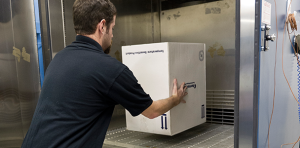DDL is pleased to announced its Eden Prairie, MN and Fountain Valley, CA facilities have received ISO/IEC 17025:2005 accreditation from the American Association for Laboratory Accreditation (A2LA).
 ISO/IEC 17025:2005 is the international standard by which a laboratory’s commitment to quality and technical competence are evaluated. DDL achieved ISO/IEC 17025:2005 accreditation by demonstrating its laboratories are in compliance with the standard and A2LA accreditation requirements. This accreditation covers distribution testing, and strength and integrity testing.
ISO/IEC 17025:2005 is the international standard by which a laboratory’s commitment to quality and technical competence are evaluated. DDL achieved ISO/IEC 17025:2005 accreditation by demonstrating its laboratories are in compliance with the standard and A2LA accreditation requirements. This accreditation covers distribution testing, and strength and integrity testing.
“Receiving accreditation for our laboratories demonstrates to our customers that we continue to adhere to the highest level of quality assurance,” said Corey Hensel, General Manager, DDL, Inc. “Combined with our recently renewed ISO 9001:2008 certification, the ISO/IEC 17025:2005 accreditation validates DDL’s commitment to continuously improving our quality program in an effort to offer superior service within our industry.”
“ISO/IEC 17025: 2005 is becoming an essential standard for testing facilities serving the medical device industry,” said Patrick Waddick, Quality Assurance Manager, DDL, Inc. “This accreditation further reaffirms our technical competency and capability to produce precise and accurate test data that our customers can rely upon to meet their regulatory requirements.”
Please visit www.testedandproven.com/about-ddl/certifications/ to download a copy of DDL’s ISO/IEC 17025:2005 accreditation.
 The ISO 10555-6:2015 standard specifies requirements, performance, and user safety issues related to subcutaneous implanted ports and catheters for intravascular long-term use supplied in sterile condition and intended for single use.
The ISO 10555-6:2015 standard specifies requirements, performance, and user safety issues related to subcutaneous implanted ports and catheters for intravascular long-term use supplied in sterile condition and intended for single use. A number of testing standards have been developed for the testing of syringes. These standards, however, don’t specifically address pre-filled glass syringes. In April 2013, the FDA released a guidance document on the use of a couple of ISO standards for use in the
A number of testing standards have been developed for the testing of syringes. These standards, however, don’t specifically address pre-filled glass syringes. In April 2013, the FDA released a guidance document on the use of a couple of ISO standards for use in the  One way to explain the use of the Arrhenius equation and Accelerated Aging Factor (AAF) Determination to someone outside of the profession is to describe it as a time machine. The use of these equations allows the engineer to essentially make time go faster in order to prove out their packaging that much sooner.
One way to explain the use of the Arrhenius equation and Accelerated Aging Factor (AAF) Determination to someone outside of the profession is to describe it as a time machine. The use of these equations allows the engineer to essentially make time go faster in order to prove out their packaging that much sooner. ASTM D4169-09 recently has been revised to ASTM D4169-14. ASTM D169 is the test method performed by subjecting shipping units to a test plan consisting of a sequence of hazard elements which would be encountered in various distribution environments.
ASTM D4169-09 recently has been revised to ASTM D4169-14. ASTM D169 is the test method performed by subjecting shipping units to a test plan consisting of a sequence of hazard elements which would be encountered in various distribution environments.